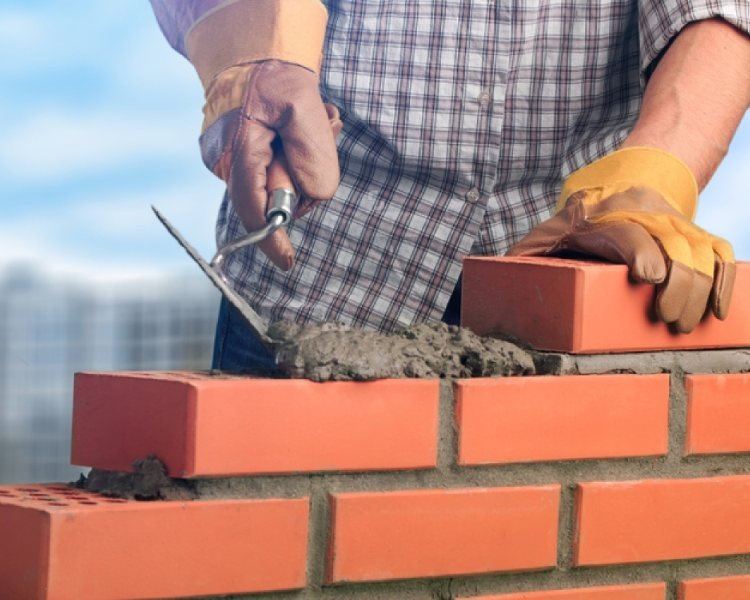Unlocking the Keys of Lasting Masonry Building And Construction Practices for Eco-Friendly Buildings
Amongst the myriad methods to environment-friendly building, lasting masonry building and construction stands out as a time-tested and long lasting approach that holds a wealth of untapped capacity. From the option of products to cutting-edge construction techniques, the secrets to achieving sustainability within stonework building and construction are complex and fascinating.
Advantages of Sustainable Masonry Building
Accepting lasting masonry building and construction techniques not only minimizes environmental impact yet additionally offers lasting economic advantages to building contractors and neighborhoods. By utilizing products like recycled blocks, obstructs, and rocks, home builders can substantially reduce the carbon impact of their tasks while advertising source effectiveness. Furthermore, lasting masonry building and construction techniques, such as correct insulation and thermal mass homes, can enhance energy performance within buildings, causing decreased functional expenses over time.
Moreover, the sturdiness and resilience of masonry structures contribute to long-term economic benefits. Structures created using lasting masonry practices usually need less repair and maintenance, converting to cost financial savings for builders and residential or commercial property owners. The long life of masonry products additionally makes sure that structures continue to be secure and safe, minimizing the need for regular renovations or substitutes.
Eco-Friendly Stonework Products
Making use of environment-friendly masonry products is a crucial action in the direction of improving the sustainability of building and construction techniques and lessening environmental effect while making best use of long-term financial advantages. Sustainable masonry products are sourced, produced, and utilized in a manner that lowers overall environmental effect. Materials such as recycled bricks, redeemed rock, and sustainable concrete blocks are ending up being progressively popular choices for eco-conscious building contractors. Recycled bricks, for instance, not just draw away waste from land fills however also need much less power to generate contrasted to brand-new bricks. Recovered rock provides a distinct visual charm while minimizing the demand for new quarrying. Lasting concrete blocks integrate recycled accumulations and might feature improved insulation properties, adding to power effectiveness in structures.
Furthermore, all-natural products like adobe, rammed planet, and straw bales offer superb thermal mass residential or commercial properties, decreasing the demand for home heating and cooling energy. These products are commonly in your area offered, promoting local economic situations and decreasing transportation-related carbon discharges. By picking green masonry products, building tasks can substantially reduce their ecological impact and add to the creation of healthier, extra lasting developed environments.
Energy-Efficient Stonework Strategies
Energy effectiveness plays an important duty in improving the sustainability of masonry building methods. One crucial energy-efficient stonework method is the usage of thermal mass, which concrete slab construction entails integrating dense materials like concrete or brick right into the building's framework to soak up and save heat.

Innovations in Sustainable Stonework
Current innovations in lasting masonry practices have actually produced innovative techniques that are improving the building sector. One such advancement is the development of self-healing concrete, which utilizes bacteria installed within the concrete to recover splits autonomously. This advancement not just minimizes maintenance expenses however also boosts the resilience of stonework structures, adding to their sustainability.
An additional noteworthy development is using recycled accumulations in masonry building - masonry contractor. By integrating materials such as crushed ceramic waste or recycled glass into concrete blends, builders can reduce the ecological impact of building and construction tasks while maintaining structural honesty. This practice not only draws away waste from garbage dumps but also conserves natural deposits, making it a key advancement in sustainable masonry building
In addition, the combination of electronic design tools, such as Building Information Modeling (BIM), is transforming the means stonework structures are intended and built. BIM allows for even more accurate estimations, lowered material wastefulness, and enhanced power effectiveness, inevitably leading to more lasting building techniques. These developments jointly indicate a promising future for lasting masonry building and construction in the period of eco-friendly structures.
Future Trends in Masonry Sustainability
With the batching of concrete innovative strides made in anchor lasting stonework techniques, the future fads in stonework sustainability are poised to further change the building sector. One of the key trends forming the future of stonework sustainability is the raised assimilation of modern technology. Advancements such as Structure Details Modeling (BIM) and digital reality simulations are being used to optimize stonework construction procedures, causing lowered product waste and improved power effectiveness in buildings.
Moreover, the advancement of novel lasting products is readied to play a substantial function in boosting the eco-friendliness of masonry construction. masonry contractor. Technologies like self-healing concrete, recycled aggregates, and bio-based binders are getting grip for their capability to decrease ecological impact while maintaining structural honesty

Conclusion
To conclude, lasting masonry building techniques offer many advantages for green buildings. By using green materials and energy-efficient strategies, masonry can add to a more sustainable constructed setting. Developments in lasting masonry are continuously being created to better improve the ecological efficiency of buildings. Looking towards the future, the fad of masonry sustainability is expected to expand, resulting in more ecologically pleasant and energy-efficient construction techniques in the years to come.